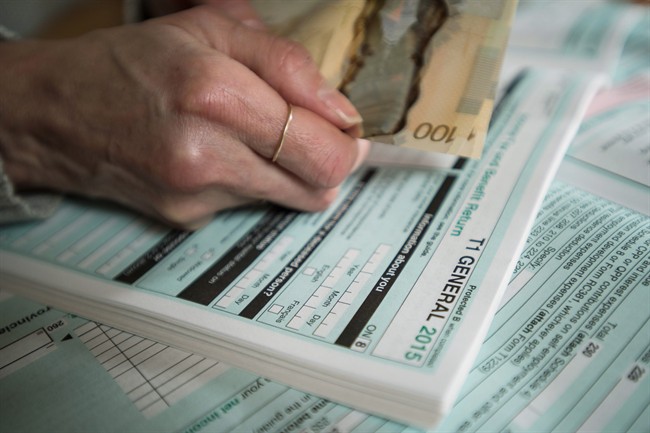It’s tax time in Saskatchewan, the time of year when you look over how much money you made in the previous year and hope that the government has to pay you back.

At times, the information contained in forms, receipts and deduction guides can be overwhelming.
Global News has compiled a few tips for Saskatchewan taxpayers to make the filing process a little less painful.
What is the deadline for filing my taxes?
April 30 — if you have a balance owing. The regular filing deadline is April 30, but since that falls on a Sunday this year, the CRA will consider your taxes filed on time as long as they are received or postmarked on or before May 1.
June 15 — If you or your spouse or common-law partner ran a business in 2016. But you still have to pay your taxes by April 30 if you owe money to the government.
What are the Saskatchewan tax brackets?
The first $44,601 of taxable income — pay 11 per cent in tax
Next $82,829 of taxable income — pay 13 per cent in tax
Any taxable income over $127,430 — pay 15 per cent in tax
What are some of the Saskatchewan tax credits?
Basic personal amount: $15,843
Spousal/equivalent amount: You can claim up to $15,843. The amount is determined by subtracting your spouse’s or equivalent’s net income from $17,428. Claim the remainder or $15,843, whichever is the lesser amount.
Dependent child: You can claim $6,010 for each child who was under the age of 18 at any time during 2016 and who was living with you on Dec. 31, 2016. A child for which you have claimed the eligible dependent amount cannot be claimed as a dependent child as well. The lower income spouse should claim all the children and any unused amount can be transferred to the higher income spouse.
Age credit: If you were 65 or older on Dec. 31, 2016, and your net income is less than $35,927, you can claim $4,826. The age amount will be reduced if your income was more than $35,927 and less than $68,101.
Senior supplement: Anyone 65 or older on Dec. 31, 2016 can claim $1,274 regardless of net income.
READ MORE: 12 unusual Canadian tax deductions that filers have tried to claim
Home buyer’s credit: $1,100 can be claimed for the purchase of a qualifying home during 2016, but it cannot be claimed if a loan was received through the Graduate Retention Program First Home Plan. The amount can be split between spouses or common-law partners, but cannot exceed $1,100. The home must be in Saskatchewan and registered with the Land Titles Registry to qualify for the credit.
Pension income amount: If you report eligible pension, superannuation or annuity payments, you can claim the amount on your federal return or $1,000, whichever is less. Only residents of Saskatchewan are eligible to claim this amount.
Graduate tuition tax credit: This credit can be claimed if you were a resident in Saskatchewan at the end of 2016, met all necessary qualifications for completing an eligible program at an eligible educational institution and obtained a graduate retention eligibility certificate from the Advanced Education Ministry.
Eligibility starts on the tax year shown on the certificate and covers a seven-year period – 10 per cent of total eligible tuition in the first four years and 20 per cent in the last three years. Any unused credit can be carried forward for nine years after graduation.
The maximum lifetime amount that can be claimed is $20,000.
READ MORE: Does it pay to leave Canada for tax reasons? Experts weigh the pros and cons
Saskatchewan mineral exploration tax credit: If you purchased shares in a mining exploration company during 2016, and the company’s exploration expense is in Saskatchewan, 10 per cent of eligible expenses can be used to reduce your Saskatchewan tax in the year it is claimed.
Unused amounts can be carried forward for 10 years or carried back three years.
Saskatchewan employee’s tools tax credit: Saskatchewan residents who were required to provide eligible tools as a condition of employment in an eligible trade can claim this one-time trade entry credit. The credits range from $148.50 to $1,375 depending on the trade.
Any credit that is not needed to reduce your provincial income tax to zero can be carried forward for two years.
You can also claim an annual maintenance credit if you are not claiming the one-time trade entry credit, your primary income is from one of the eligible trades and you were required to provide eligible tools as a condition of employment. The credits range from $33 to $275 depending on the trade.
Labour-sponsored venture capital tax credit: You can claim an investment made during 2016 into a labour-sponsored venture capital corporation that invests in small- and medium-size businesses. The maximum amount of the credit is $1,000.
Political contribution credit: Anyone contributing to a registered Saskatchewan political party during 2016 or to an independent candidate in the 2016 provincial election and who has official receipts, can claim this credit.
If the total contribution is over $1,275, a $650 credit can be claimed. The amount of the credit for contributions less than $1,275 is determined by the using the provincial worksheet.


Comments